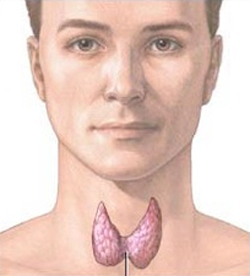
Thyroid Gland
The thyroid gland is a butterfly-shaped gland located in the neck. It is positioned on the front of the breathing tube (trachea) and partially wraps around it just below the “adams apple” (larynx). It is divided into right and left halves (lobes) connected to each other by a thin strip of thyroid tissue called the isthmus. It is shaped like a “H”. Its primary function is to make thyroxine (also known as thyroid hormone or T4), which can also be converted into another form of thyroid hormone (T3). These hormones have many direct and indirect functions. Generally, they control and regulate the body’s metabolism. Too much hormone leads to hyperthyroidism, and the patient may feel anxious, have palpitations, heat intolerance, weight loss and other more serious issues. Too little hormone leads to hypothyroidism, and the patient may experience severe fatigue, weakness, cold intolerance, weight gain and other more significant symptoms. In the extreme, either condition can be life threatening.
The thyroid gland can also develop growths within the gland. These are called nodules or masses. These can be overgrowth of normal tissue (hyperplastic) or abnormal tissue (neoplastic). Overgrowth of abnormal tissue can be either benign (noncancerous) or malignant (cancerous).
From the standpoint of a surgeon, thyroid disease that might require surgery generally falls into one of three categories:
- Thyroid nodules
- Thyroid hyperfunction
- Thyroid cancer
These categories are not mutually exclusive. A patient can have thyroid nodules and hyperfunction, thyroid cancer and hyperfunction, etc.
In addition to these topics, we have pages under the thyroid section on pre-operative care, fine needle aspiration (FNA) including a slide show of the FNA procedure, post-operative care, post-operative issues, technical details about thyroidectomy, follow-up after surgery, risk of surgery, pictures of incisions, and a video of an operation.
